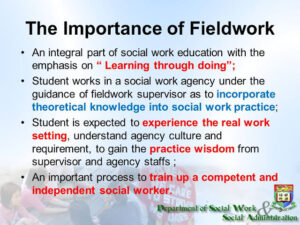Back to: Environmental Biology 100 Level
Welcome to class!
Hello superstar learner! Today, we are discussing Student Fieldwork Presentations, a topic that will help you understand how to confidently share your findings after practical field activities. Fieldwork is one of the most exciting parts of studying Environmental Biology because it allows you to see and study nature directly—whether it’s observing a forest, a water body, or a waste management site. By the end of this lesson, you will know how to prepare, organise, and deliver a strong fieldwork presentation.
Student Fieldwork Presentations
Imagine you went on a field trip with your classmates to study a river and you noticed how human activities affect its cleanliness. After the trip, you will be asked to present your findings to your class. This process of explaining what you observed, what you learnt, and what solutions you can suggest is called a fieldwork presentation.

What is Fieldwork?
Fieldwork is practical research or study done outside the classroom, where you observe, collect data, and learn directly from the environment. For example, visiting a recycling plant or farmland to study waste or soil quality is fieldwork.
What is a Fieldwork Presentation?
A fieldwork presentation is when students share their field research results with others, usually through a talk, slide show, poster, or report.
Importance of Fieldwork Presentations
Helps students improve communication and presentation skills.
Allows you to share real-life experiences with classmates.
Encourages teamwork when presenting as a group.
Helps to connect theory learned in class with practical experiences.
Builds confidence and leadership skills.
Steps to Prepare for a Fieldwork Presentation
Organise Your Data: Arrange all observations, photos, or measurements you collected.
Identify Key Points: Focus on the main findings or challenges you noticed.
Create Visual Aids: Use slides, charts, or pictures to make your presentation interesting.
Practise: Rehearse your presentation to speak clearly and confidently.
Work as a Team: If it’s a group presentation, assign roles to everyone for smooth delivery.
Tips for a Great Presentation
Start with a friendly introduction of your fieldwork topic.
Keep your points simple and easy to understand.

Use real examples from your field trip.
Speak confidently and maintain eye contact with your audience.
Conclude with key findings and possible solutions to any problems you observed.
Summary
- Fieldwork involves studying the environment outside the classroom.
- A fieldwork presentation is sharing your findings with others in a clear way.
- Presentations improve communication, confidence, and teamwork.
- Preparation involves organising data, creating visuals, and practising.
- A great presentation is simple, clear, and engaging.
Evaluation
- What is fieldwork?
- State two benefits of fieldwork presentations.
- Mention three steps to prepare for a fieldwork presentation.
- What makes a presentation engaging?
- Why is teamwork important during group presentations?
Great work, future presenter! With these tips, you will be able to confidently share your ideas and impress your audience. Afrilearn is proud of how much you’re growing into a bold and intelligent learner.
